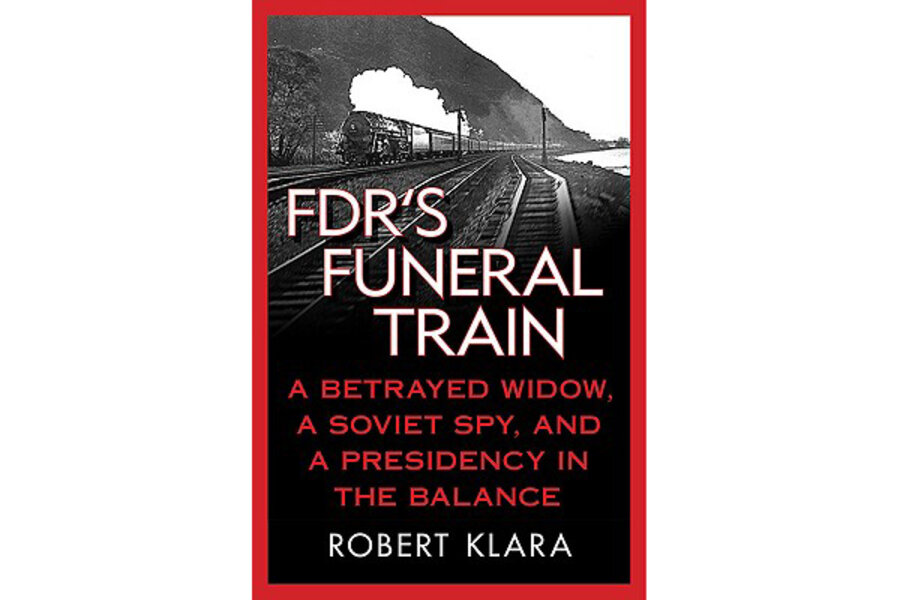FDR'S Funeral Train
Loading...
Franklin Roosevelt’s many biographers all give considerable attention to the circumstances of his death and the outpouring of grief that followed. But few of them have devoted more than passing attention to the funeral train that carried the deceased president from Warm Springs, Ga., to his final resting place in Hyde Park, N.Y.
Robert Klara fills this void with FDR’s Funeral Train: A Betrayed Widow, a Soviet Spy, and a Presidency in the Balance. He tells the story chronologically and in great detail, beginning with FDR’s death on April 12 and concluding with President Truman’s State of the Union message to Congress on April 16.
The journey took place in two parts. Roosevelt’s casket was first brought to Washington, D.C. – where it was met at Union Station by the largest crowd ever to have assembled in the city – for a brief memorial service in the White House. The second leg of the trip carried FDR from Washington to his interment at his family home.
Klara devotes roughly equal attention to the mourning for President Roosevelt and the effort of President Truman to take control of the federal government at a vitally important time in American history. Truman was woefully underprepared: In the year prior to becoming president, he had met Roosevelt just eight times and several of these were as part of cabinet meetings. Indeed, as vice president, Truman was so removed from the executive branch that he did not realize he had been given Secret Service protection until he noticed a “handsome, well-dressed stranger” sitting outside his Senate office. “Well, what the hell is this?” he asked.
One can only imagine the subjects that were discussed, positions that were established, and decisions that were made as the train made its slow and sorrowful way between Georgia and New York. It’s impossible to know for sure because there are no official records of the discussions, and those who were on the train rarely said anything more in their memoirs than “important topics were discussed.”
The volume is full of fascinating anecdotes. For example, the Roosevelts had devoted so little attention to the upkeep of the White House that the walls had turned yellow, the carpets were threadbare, and the mansion looked like “an abandoned hotel.” Eleanor had to tell the new president that the house was infested with rats.
The reader will quickly realize that Klara is writing about a vastly different era. Despite the fact that the nation was at war, there was less attention to presidential security during the journey than we expect today for even the most informal presidential trip. The train to Hyde Park, for example, carried the former president, his widow and two of her children, the new president and his entire family, the cabinet, and all the justices of the Supreme Court. Members of Congress were all on a second train.
The book’s subtitle implies more drama than the book documents. The “betrayed widow,” of course, was Eleanor Roosevelt, who had just learned that FDR’s mistress was with him when he died and, with the help of their only daughter, had been seeing him secretly for several years. The “Soviet spy” was Lauchlin Currie, an economic adviser to President Roosevelt who had been sharing documents with his KGB handlers for several years, but there is no implication that any spying occurred during the trip. “A presidency in the balance” refers to Truman’s nonstop efforts to master immediately the enormous array of political and policy issues that he now faced – not the least of which was whether or not to authorize use of the atom bomb.
Klara conducted extensive research in preparing this volume. While he consulted appropriate primary materials, much of the evidence is drawn from secondary sources. This is popular history at its best: engaging, informative and insightful. It is very well written and, except for an occasional use of obscure words, a pure pleasure to read.
The book sheds welcome light on a fascinating and largely forgotten episode of American political history.
At the end, one is left with the feeling that much about this journey is a mystery that will never be solved. But then again, one never knows. Klara points out that more than 60 years after the event many of the Secret Service documents relating to FDR’s funeral train remain classified. Perhaps one day, they will be released to the public and we will have a more complete picture. Until then, Klara’s book will more than suffice.
Terry Hartle is senior vice president of government relations for the American Council on Education.






